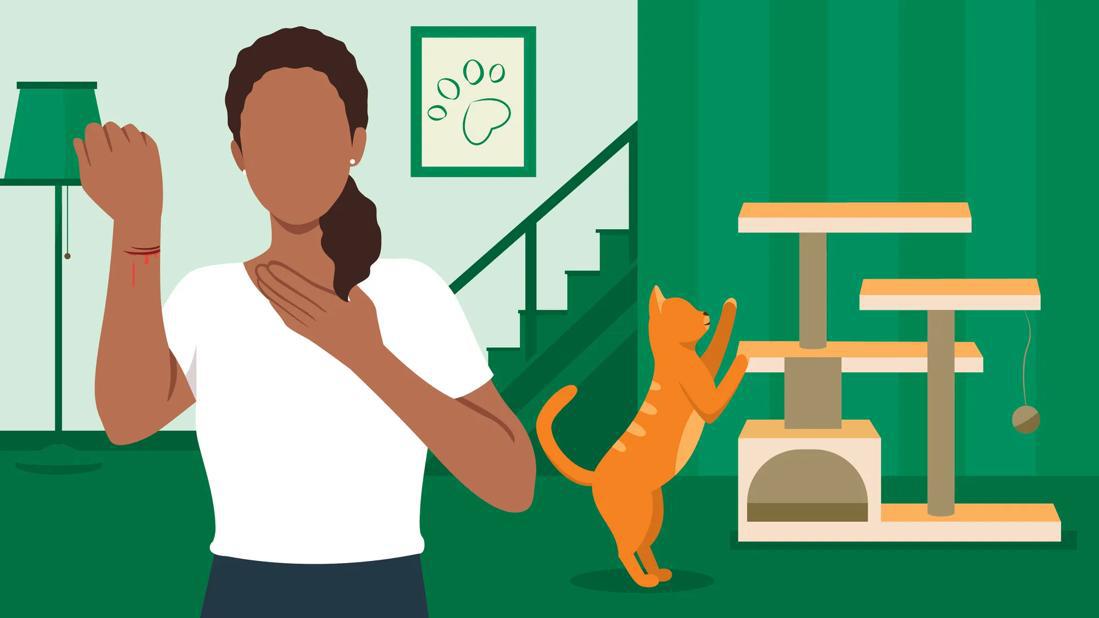Should You Worry About a Cat Bite or Scratch?
The risk of infection makes fast and thorough treatment critical

The cat you’re petting purrs with delight as you gently stroke its fur. Mr. Whiskers seems so cuddly and content — right up until the moment they turn and sink their sharp fangs or claws into your skin.
What you do next to treat your wound is very important.
That’s because cat bites and scratches bring a high risk of illness (and ickiness) from bacteria. It’s estimated that 20% to 80% of reported cat bites become infected, according to the U.S. Centers for Disease Control and Prevention (CDC).
We asked emergency medicine physician Stephen Sayles III, MD, to explain the risks of cat bites and scratches, and what you can do to best protect yourself.
The danger of cat bites
The inside of a cat’s mouth isn’t exactly the cleanest environment. It’s loaded with about 200 types of bacteria — some of which can cause a serious reaction when injected into your body via razor-sharp teeth.
Scratches come with infection risk, too, given that cat claws also carry a variety of bacteria from padding around in the world.
Bacterial infections and puncture wounds or gashes from cats can be severe, warns Dr. Sayles. The risk of complications from an infection rises if you’re immunocompromised or have diabetes.
“See a doctor within eight hours to cut your infection risk,” he advises. “You may need intravenous [through a vein] antibiotics or — in some cases — you may even need to be hospitalized.”
One study found that 30% of people who sought treatment for a cat bite on their hand ended up being hospitalized. The average stay was more than three days.
What infections can a cat pass along?
Bacterial infections associated with cat bites and/or scratches include:
- Pasteurella.This bacteria lives in the mouths of 70% to 90% of cats, which explains why it’s the most common infection following a bite or scratch. Signs of infection may appear within a few hours of the wound with pain, swelling and tenderness.
- Cat scratch disease (CSD). Better known as “cat scratch fever,” this infection can lead to swollen lymph nodes, a rash or skin bumps, fever, fatigue and muscle aches. Cats typically get the bacteria from fleas before passing it on.
- Campylobacteriosis. Contact with cats and other animals (or their poop) is a recognized risk factor for a Campylobacter infection. Symptoms include stomach cramps, fever, nausea and diarrhea.
- Rabies. While potentially deadly rabies infections are now relatively rare in the United States thanks to pet and wild animal vaccinations, it remains a risk — particularly if you’re bitten by a stray or feral cat.
- Tetanus.A vaccine for tetanus may be recommended after a cat bite to guard against the painful muscle contractions that can be brought on by the bacteria.
How long does it take an infection to set in?
Signs of infection from a cat bite or scratch can begin appearing within a few hours of the feline encounter. It may take as long as 10 days for symptoms of cat scratch fever to show. Rabies can take weeks or months to progress.
Treating a cat bite or scratch
Given concerns about bacteria, cleaning the wound is the No. 1 priority when treating a cat bite or scratch.
Start by rinsing the wound with water to flush out as much bacteria as possible, instructs Dr. Sayles. Be gentle to avoid pushing bacteria deeper into the wound.
Next, wash the wound with soap and water. Slow the bleeding with a clean cloth and apply an over-the-counter antibiotic cream if you have it, he recommends. Then, wrap the wound in a sterile bandage.
Keep the wound bandaged until you see a healthcare provider. Again, the goal should be to get professional treatment within eight hours to help reduce the risk of infection.
A provider will likely do the following:
- Clean the wound again and apply antibiotic ointment
- Prescribe antibiotics if there’s an infection concern
- Give you a booster shot if your tetanus vaccine is out-of-date
- Consider your risk of rabies
- Determine whether the wound needs stitches
Plan to change your bandage several times a day as the wound heals. Watch for signs of infection — including redness, swelling, increased pain and fever — in the days that follow, says Dr. Sayles.
Tips to prevent cat bites and scratches
Even though a cat may seem sweet when it’s purring or softly meowing, the reality is that they can bite and scratch. You can reduce your risk of being wounded and infected by a cat fang or claw by:
- Avoiding rough play, which can lead to cats being defensive
- Keeping your cat’s nails trimmed
- Be cautious (or avoid) petting unfamiliar cats, especially if they’re a stray and don’t look healthy
In addition, always wash your hands after touching a cat and after cleaning their litter box.